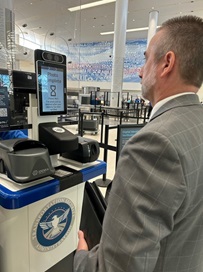The US Transportation and Safety Administration (TSA) has installed its first automated biometric screeners at the busy Baltimore Washington International Airport (BMI), raising privacy concerns among advocates and US lawmakers.
Three dozen of the credential authentication technology (CAT) units – each featuring a camera to match the photo on a person’s ID, with the person presenting the ID – were installed at BMI security checkpoints last week.
TSA spokesperson for the Northeast, Lisa Farstein, said the self-serve units will “reduce touchpoints” by eliminating the need for TSA officers to handle passenger boarding passes or photo IDs. “The benefits: improved efficiency, convenient for travelers and enhanced security,” Farstein tweeted about the cutting edge technology. The devices will also allow one TSA officer to staff multiple security gates simultaneously, streamlining the checkpoint process.
Christopher Murgia, TSA’s Federal Security Director for Maryland, said the second generation CAT-2 biometric screeners help to ensure the TSA knows exactly who is boarding flights.
“The system also confirms the passenger’s flight status by verifying that the individual is ticketed to fly out of that airport on that day,” said Murgia. The facial recognition technology is said to enhance detection capabilities for identifying fraudulent documents at the security checkpoint, according to the TSA.
But not everyone is happy with the idea of their biometric data being held in storage servers being controlled by a government agency. According to a January 2022 TSA privacy impact report on the automated technology, during routine screening operations, TSA will delete the Secure Flight passenger data stored on CAT-2 within 24 hours of the original flight departure time.
The report also states once a CAT-2 device matches the photo ID to the face of the person standing in front of it, the CAT-2 device immediately overwrites the live image when the next passenger scan begins, or if an agent logs out of the machine. But in other instances, exactly how long a person’s image and information will be stored is murky at best.
For example, when a passenger presets their photo ID to a booking or airline agent, that photo is then held in the TSA’s Secure Flight system, the report states. The Secure Flight system sends that photo to the CAT-2 screener in preparation for the passenger’s arrival, where they will go through the same authentication process, this time at the destination’s security checkpoint.
An agent will compare the stored TSA photo to the photo ID manually presented by the passenger, or if the airport is equipped with facial recognition software, require the person to take another live photo for comparison on the spot. How long those passenger photos are being saved for each leg of their trip is certainly not clear.








